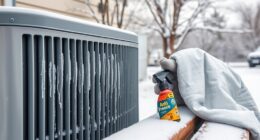To shift smoothly from a fossil fuel system to a heat pump, start by consulting HVAC professionals to ensure proper sizing and installation. Plan for integrating renewable energy sources like solar panels or wind turbines to power your heat pump efficiently. Improve your home’s insulation to boost performance and reduce energy loss. Take advantage of available rebates and tax incentives to offset costs. If you want to learn more about making this switch easier, keep exploring the best strategies and tips.
Key Takeaways
- Consult HVAC professionals for proper system sizing, placement, and integration with renewable energy sources.
- Assess and improve home insulation to maximize heat pump efficiency and reduce energy loss.
- Explore local and federal incentives or rebates to offset installation costs and encourage a smooth transition.
- Plan electrical system upgrades as needed to support the new heat pump and renewable energy connections.
- Gradually phase out fossil fuel systems, ensuring proper system decommissioning and environmental considerations.

Are you considering switching to a heat pump for your heating and cooling needs? Making the transition from a fossil fuel system can seem daunting, but with the right approach, it becomes a straightforward process. One of the first steps is understanding how to integrate renewable energy sources into your home’s heating and cooling system. Heat pumps are inherently energy-efficient and work well with renewable integration, especially if you have access to solar panels or wind turbines. By pairing your heat pump with renewable energy, you reduce reliance on fossil fuels even further, cutting down your carbon footprint and lowering energy bills in the long run. This synergy not only enhances your home’s sustainability but also positions you to take advantage of various government incentives designed to promote clean energy solutions. Many local and federal programs offer rebates, tax credits, or other financial benefits that can significantly offset the upfront costs of installing a heat pump. It’s worth researching what incentives are available in your area, as these can make the switch more affordable and financially rewarding.
Once you’ve identified the right heat pump system for your home, the next step is planning the installation process carefully. Consulting with qualified HVAC professionals ensures your new system is properly sized and positioned for optimal performance. They can also guide you on integrating renewable energy sources, such as connecting your solar panels to power the heat pump directly or designing your home’s electrical system to support renewable integration. During installation, it’s essential to consider factors like insulation and ductwork to maximize efficiency. Properly insulating your home reduces energy loss, allowing the heat pump to operate more effectively and save you money over time. Additionally, understanding the importance of heat pump efficiency ratings can help you select a system that offers optimal seasonal performance and long-term savings.
Transitioning from a fossil fuel system involves some adjustments, but it’s worth the effort. Your utility bills will drop, and you’ll contribute to a cleaner environment. Using government incentives can further ease this transition, making the switch more financially feasible. Keep in mind that many regions are actively promoting renewable integration, so local policies may support your efforts through additional programs or grants. Educate yourself about these opportunities, and don’t hesitate to ask your installer about available incentives and how to qualify. As you move forward, maintaining your heat pump and ensuring your home is well-insulated will help you enjoy consistent comfort and maximum savings. Ultimately, switching to a heat pump not only benefits your wallet but also supports a sustainable future, especially when combined with renewable energy and government support.
Frequently Asked Questions
What Are the Initial Costs of Installing Heat Pumps?
The initial costs of installing heat pumps typically range between $3,000 and $8,000, depending on the system type and your home’s size. When considering the cost comparison, installation process plays a key role; professional installation ensures efficiency but may add to expenses. Factors like ductwork upgrades or electrical work can influence overall costs. While upfront expenses might seem high, energy savings can make heat pumps a cost-effective choice long-term.
How Long Does a Typical Heat Pump Installation Take?
A typical heat pump installation takes about one to three days, depending on your home’s size and existing setup. You should plan your project scheduling accordingly, allowing for any necessary system modifications or upgrades. During the installation timeline, make certain you’re available for inspections and to address potential delays. Proper planning helps you shift seamlessly without extended disruptions, guaranteeing your new heat pump operates efficiently from day one.
Are Heat Pumps Effective in Extremely Cold Climates?
Coincidentally, you’ll find that modern heat pumps are surprisingly effective in cold climates, despite efficiency challenges. Advanced models now operate efficiently even in freezing temperatures, providing reliable heating. Look for cold climate heat pumps designed specifically for low temperatures, and make certain of proper installation to maximize their performance. While they might not match the power of traditional systems in extreme cold, they still offer a sustainable, effective alternative that can keep your home warm.
What Incentives or Rebates Are Available for Switching?
You can take advantage of rebate programs and financial incentives offered by local governments, utility companies, and manufacturers. These programs often provide rebates that reduce your upfront costs, making switching to a heat pump more affordable. Check with your utility provider or government websites to find available incentives in your area. Act now to save money while upgrading to an energy-efficient heating and cooling system that benefits both your wallet and the environment.
How Does Maintenance for Heat Pumps Compare to Fossil Fuel Systems?
Maintenance for heat pumps generally requires less effort and cost than fossil fuel systems. You’ll experience a lower repair frequency because heat pumps have fewer moving parts and are built for durability. Regular filter changes and annual professional check-ups keep them running efficiently. In contrast, fossil fuel systems often need more frequent repairs due to their complex components, such as burners and pumps, making heat pumps a more convenient, low-maintenance choice.
Conclusion
Switching to heat pumps is a smart move for a greener future. Did you know that heat pumps can reduce your energy bills by up to 50%? By planning your upgrade carefully and choosing the right system, you’ll enjoy comfort and efficiency without hassle. Remember, a smooth shift benefits both your wallet and the planet. Take the first step today, and you’ll be part of the solution to a cleaner, more sustainable energy future.








